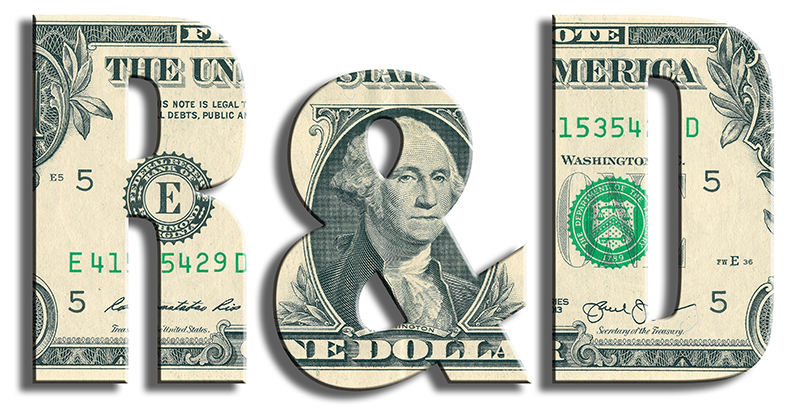The R&D World Index (RDWI) for the week ending September 16, 2022, closed at 2,300.52 for the 25 companies in the RDWI. The Index was down -3.86% (or 92.39 basis points) from the week ending September 9, 2022. Eight of the 25 RDWI members gained value from 0.05% (Sanofi SA) to 6.64% (Volkswagen AG). Seventeen of the 25 RDWI members lost value last week from -1.49% (IBM) to -13.51% (Facebook/Meta).
RDW Index member Apple Inc., Cupertino, California, announced last week that its new iPhone 14s will be able to beam short distress messages and location data from places off the cellular grid by November. This service will initially cover the U.S. and Canada but could be expanded to more countries in the future. Apple contracted with Globalstar Inc., Covington, Louisiana, in 2019 for 85% of the satellite company’s network capacity. Apple, Huawei and Alphabet/Google are all integrating these new technologies so that ordinary smartphone users can stay connected in remote areas. Apple stated that this new service, Emergency SOS via satellite would be free to iPhone 14 users for the first two years. Huawei stated last week that its new Mate 50 smartphones will be able to send short messages in emergencies over the BeiDou Navigation Satellite System (China’s version of the U.S. Global Positioning System (GPS)).
RDW Index member Google, Mountain View, California, announced last week that it is reducing by 50% its in-house R&D division, known as Area 120, which is an in-house incubator for experimental new products. Its current 14 projects will be cut to 7 with associated staff cuts. Those projects being cut include a service offering web storefronts for digital creators, a financial accounting project, analytics for augmented and virtual reality and three climate-related projects. The company also commented that it may still need to restructure teams, deprecate products and possibly even eliminate R&D roles.
Automaker Tesla Inc., Austin, Texas, announced last week that it is pausing its plans to develop electric vehicle (EV) battery cells in Germany as it considers qualifying for U.S. EV and battery manufacturing tax credits. Making batteries in the U.S. could also help Tesla qualify for additional tax breaks under the Biden Administration’s recent Inflation Reduction Act. Tesla and its EV cell supplier Panasonic are likely to be one of the early beneficiaries of the EV battery production incentives.
TeraWatt Infrastructure Inc., San Francisco, announced last week that it has raised more than $1 billion to develop and build EV charging stations for commercial fleets of cars, vans and trucks. The company already has sites in 18 states where it expects to install charging stations by the end of 2023. Commercial charging stations are technically complex due to the large electric loads and the amount of infrastructure needed. Utilities, permitting and safety are all increasingly more complex than charging systems for cars. The maximum commercial charging demand can be up to 20 times that of a station serving passenger cars.
Semiconductor maker Solidigm, San Jose, California, last week announced that it will be creating about 750 R&D jobs in Rancho Cordova, California, (near Sacramento) over the next five years. The total number of jobs in the 230,000-ft2 space Solidigm will be occupying will be close to 2,000, the bulk of which are former Intel employees in Folsom, California, that Solidigm is relocating to Rancho Cordova.
Intuitive Machines LLC, Houston, announced last week that it is nearing completion of a special-purpose acquisition company (SPAC) with Inflection Point Acquisition Corp., New York City, which would take the space exploration infrastructure provider public to a valuation exceeding $1 billion. NASA has hired Intuitive to deploy its Nova-C lunar lander to the moon and will use a company “hopper” robot on a separate lunar mission. Both programs are part of NASA’s Artemis program which is scheduled to occur over the next few years. The first Artemis moon rocket is now scheduled to launch on September 27 at NASA’s Kennedy Space Center, Florida, following two scrubs over the past two months due to fuel leaks in the booster rocket.
U.S. and Mexico trade officials met last week in Mexico City, to discuss plans that could boost regional production of semiconductors and renewable energy projects. U.S. representatives discussed details of the recently signed $280 billion Chips and Science Act and the Inflation Reduction Act. They also requested that Mexico address its energy policies which currently obstruct operations of U.S. companies which have invested heavily in Mexico’s energy sector. Mexico’s current regulations hinder fuel imports by U.S. companies and prioritize the Mexican utility on the grid over private power generators, including solar and wind plants.
Drugmaker Acelyrin, Woodland Hills, California, announced last week that it had raised $300 million in new venture capital (from Access Biotechnology, New York City) to run late-stage clinical trials of a drug, izokibep, for the treatment of psoriatic arthritis and axial spondyloarthritis. Acelyrin hopes that its drug will emerge as best in a class of medicines known as IL-17A inhibitors, which includes Novartis AG’s Cosentyx.
Last week the U.S. Department of Labor announced that consumer prices rose by 0.1% in August from July putting them at 8.3% above their year-earlier value. This continued high inflation rate dampened any investor hopes that the Federal Reserve might reconsider its plans to raise interest rates at its next meeting this week. This data almost assures that the fed will raise rates this week by another 0.75% following similar 0.75% increases in June and July. The fed could also raise rates again in November and December and even in the early months of 2023.
R&D World’s R&D Index is a weekly stock market summary of the top international companies involved in R&D. The top 25 industrial R&D spenders in 2020 were selected based on the latest listings from Schonfeld & Associates’ June 2020 R&D Ratios & Budgets. These 25 companies include pharmaceutical (10 companies), automotive (6 companies) and ICT (9 companies) who invested a cumulative total of nearly 260 billion dollars in R&D in 2019, or approximately 10% of all the R&D spent in the world by government, industries and academia combined, according to R&D World’s 2021 Global R&D Funding Forecast. The stock prices used in the R&D World Index are tabulated from NASDAQ, NYSE and OTC common stock prices for the companies selected at the close of stock trading business on the Friday preceding the online publication of the R&D World Index.




Tell Us What You Think!